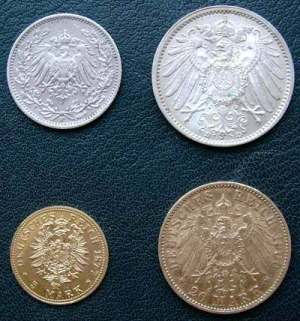German Currency Over The Years Posted by Constanze on May 29, 2019 in Uncategorized
Guten Tag! Today we’re going to look at German Geld (money). Germany’s current currency is the Euro, but it’s only been that way since 2002. In this post we’ll look at German currency (die Währung) from over the years.
We start in the period of the German Empire. Between 1873 and 1914, German currency was called the Goldmark. More accurately, Goldmark was the name given to this currency later on, to distinguish it from its successor, the Papiermark, first introduced in 1914. The currency at the time was simply called the ‘Mark’.
The Goldmark was so-called because it adhered to the gold standard (der Goldstandard in German). However, this currency changed in 1914 to what was later called the Papiermark (‘Paper mark’).
1914 marked the start of World War I (der Erste Weltkrieg in German), and due to the war, Germany experienced huge inflation (die Inflation) and started printing a lot more money to try and keep up. They switched from gold to paper (hence the Papiermark) because it was cheaper and could be made in larger quantities. The economy all but collapsed in the era of the Papiermark, with one US dollar equalling 4,200 billion German Papiermarks in 1923!
Following the end of der Erste Weltkrieg, currency changed again, this time to the Rentenmark. Often shortened to ‘RM’, the Rentenmark translates to ‘pension mark’. The Rentenmark was introduced as a temporary currency to smooth the transition from the Papiermark to the Reichsmark, as it would later be known. Only a limited amount of this currency was printed, which stabilised the economy (die Wirtschaft) and helped German money rise in value again. In 1924 the name of the currency changed from Rentenmark to Reichsmark.
The name ‘Reichsmark’ comes from Deutsches Reich (German Reich), the name for Germany from 1871-1945.
1945 marks the end of der Zweite Weltkrieg (World War 2), when Germany was under allied occupation by France, UK, USA and the Soviet Union. In 1948, a new currency – the Deutsche Mark – was introduced.
While Germany was divided into east and west, West Germany (Bundesrepublik Deutschland (BRD) continued using the Deutsche Mark. East Germany (Deutsche Demokratische Republic (DDR) had its own currency, which had different names over the years: In 1964 it was called Mark der Deutschen Notenbank, and in 1968 the name changed to Mark der DDR. Those in the West referred to it as the Ostmark (‘East Mark’).
After the unification (die Wiedervereinigung in German), Germany continued using the Deutsche Mark.
This was up until 2002, when Germany adopted the Euro.
So to recap, in order:
The Goldmark (1873 – 1914)
The Papiermark (1914 – 1923)
The Rentenmark (1923 – 1924)
The Reichsmark (1924 – 1948)
The Deutsche Mark (1948 – 2002)
(with the ‘Mark der DDR’ used in East Germany from 1948-1990)
The Euro (2002 – present)

Build vocabulary, practice pronunciation, and more with Transparent Language Online. Available anytime, anywhere, on any device.








Comments:
Joseph T Madawela:
very interesting! thanks
Constanze:
@Joseph T Madawela glad you found it interesting, Joseph!